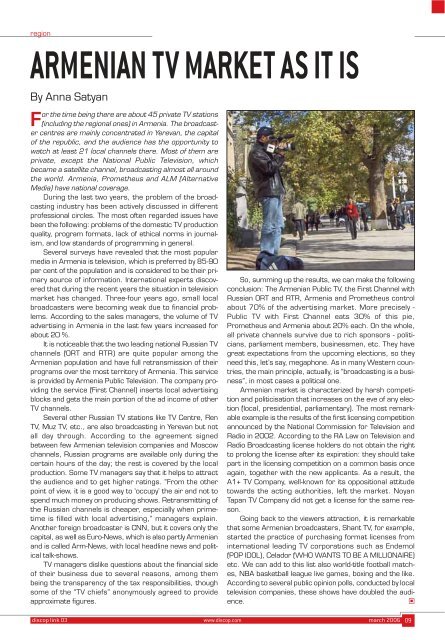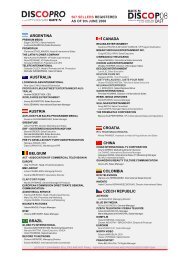TELENOVELA BLOCK.pages 24 - 30: - Discop
TELENOVELA BLOCK.pages 24 - 30: - Discop
TELENOVELA BLOCK.pages 24 - 30: - Discop
Create successful ePaper yourself
Turn your PDF publications into a flip-book with our unique Google optimized e-Paper software.
egion<br />
ARMENIAN TV MARKET AS IT IS<br />
By Anna Satyan<br />
For the time being there are about 45 private TV stations<br />
(including the regional ones) in Armenia. The broadcaster<br />
centres are mainly concentrated in Yerevan, the capital<br />
of the republic, and the audience has the opportunity to<br />
watch at least 21 local channels there. Most of them are<br />
private, except the National Public Television, which<br />
became a satellite channel, broadcasting almost all around<br />
the world. Armenia, Prome theus and ALM (Alternative<br />
Media) have national coverage.<br />
During the last two years, the problem of the broadcasting<br />
industry has been actively discussed in different<br />
professional circles. The most often regarded issues have<br />
been the following: problems of the domestic TV production<br />
quality, program formats, lack of ethical norms in journalism,<br />
and low standards of programming in general.<br />
Several surveys have revealed that the most popular<br />
media in Armenia is television, which is preferred by 85-90<br />
per cent of the population and is considered to be their primary<br />
source of information. International experts discovered<br />
that during the recent years the situation in television<br />
market has changed. Three-four years ago, small local<br />
broadcasters were becoming weak due to financial problems.<br />
According to the sales managers, the volume of TV<br />
advertising in Armenia in the last few years increased for<br />
about 20 %.<br />
It is noticeable that the two leading national Russian TV<br />
channels (ORT and RTR) are quite popular among the<br />
Armenian population and have full retransmission of their<br />
programs over the most territory of Armenia. This service<br />
is provided by Armenia Public Television. The company providing<br />
the service (First Channel) inserts local advertising<br />
blocks and gets the main portion of the ad income of other<br />
TV channels.<br />
Several other Russian TV stations like TV Centre, Ren<br />
TV, Muz TV, etc., are also broadcasting in Yerevan but not<br />
all day through. According to the agreement signed<br />
between few Armenian television companies and Moscow<br />
channels, Russian programs are available only during the<br />
certain hours of the day; the rest is covered by the local<br />
production. Some TV managers say that it helps to attract<br />
the audience and to get higher ratings. “From the other<br />
point of view, it is a good way to ‘occupy’ the air and not to<br />
spend much money on producing shows. Retransmitting of<br />
the Russian channels is cheaper, especially when primetime<br />
is filled with local advertising,” managers explain.<br />
Another foreign broadcaster is CNN, but it covers only the<br />
capital, as well as Euro-News, which is also partly Armenian<br />
and is called Arm-News, with local headline news and political<br />
talk-shows.<br />
TV managers dislike questions about the financial side<br />
of their business due to several reasons, among them<br />
being the transparency of the tax responsibilities, though<br />
some of the “TV chiefs” anonymously agreed to provide<br />
approximate figures.<br />
So, summing up the results, we can make the following<br />
conclusion: The Armenian Public TV, the First Channel with<br />
Russian ORT and RTR, Armenia and Prometheus control<br />
about 70% of the advertising market. More precisely -<br />
Public TV with First Channel eats <strong>30</strong>% of this pie,<br />
Prometheus and Armenia about 20% each. On the whole,<br />
all private channels survive due to rich sponsors - politicians,<br />
parliament members, businessmen, etc. They have<br />
great expectations from the upcoming elections, so they<br />
need this, let’s say, megaphone. As in many Western countries,<br />
the main principle, actually, is “broadcasting is a business”,<br />
in most cases a political one.<br />
Armenian market is characterized by harsh competition<br />
and politicisation that increases on the eve of any election<br />
(local, presidential, parliamentary). The most remarkable<br />
example is the results of the first licensing competition<br />
announced by the National Commission for Television and<br />
Radio in 2002. According to the RA Law on Television and<br />
Radio Broadcasting license holders do not obtain the right<br />
to prolong the license after its expiration: they should take<br />
part in the licensing competition on a common basis once<br />
again, together with the new applicants. As a result, the<br />
A1+ TV Company, well-known for its oppositional attitude<br />
towards the acting authorities, left the market. Noyan<br />
Tapan TV Company did not get a license for the same reason.<br />
Going back to the viewers attraction, it is remarkable<br />
that some Armenian broadcasters, Shant TV, for example,<br />
started the practice of purchasing format licenses from<br />
international leading TV corporations such as Endemol<br />
(POP IDOL), Celador (WHO WANTS TO BE A MILLIONAIRE)<br />
etc. We can add to this list also world-title football matches,<br />
NBA basketball league live games, boxing and the like.<br />
According to several public opinion polls, conducted by local<br />
television companies, these shows have doubled the audience.<br />
}<br />
discop link 03 www.discop.com march 2006 09
















